Satellite-Based Detection of Algal Blooms in Large Alpine Lake Sevan: Can Satellite Data Overcome the Unavoidable Limitations in Field Observations?
Abstract
1. Introduction
- Collect available monitoring information about algal blooms from in situ monitoring and expert-based assessment of algal blooms based on the visual inspection of true-color RGB satellite imagery.
- Identify a robust remote sensing-based indicator to detect algal blooms and to enable operational monitoring.
- Characterize the water temperature conditions during blooming phases in the lake.
- Identify the added value of using remote sensing for monitoring algal blooms in Lake Sevan and its information value for decision makers.
2. Materials and Methods
2.1. Study Area
2.2. In Situ Measurements for Chlorophyll and Water Temperature
2.3. Remote Sensing
2.3.1. Chlorophyll Concentration, Secchi Disc Depth and Harmful Algal Bloom (HAB) Indicator
2.3.2. Water Temperature
2.4. Expert-Based Bloom Detection by Inspecting RGB Orthophotos
2.5. Statistical Analysis
3. Results
3.1. Comparison of In Situ-Measured and Remotely Retrieved Data
3.1.1. Chlorophyll
3.1.2. Water Temperature
3.2. Bloom Detection by RGB Orthophoto Evaluation and Satellite-Based HAB Indicator
4. Discussion
4.1. Limitations of Our Approaches and Results
4.2. Implications from This Study for Lake Management
4.3. Future Needs and Next Steps
5. Conclusions
Supplementary Materials
Author Contributions
Funding
Data Availability Statement
Acknowledgments
Conflicts of Interest
References
- Ho, J.C.; Michalak, A.M.; Pahlevan, N. Widespread global increase in intense lake phytoplankton blooms since the 1980s. Nature 2019, 574, 667–670. [Google Scholar] [CrossRef] [PubMed]
- Politi, E.; Cutler, M.E.J.; Carvalho, L.; Rowan, J.S. A global typological approach to classify lakes based on their eutrophication risk. Aquat. Sci. 2024, 86, 52. [Google Scholar] [CrossRef]
- Blix, K.; Pálffy, K.; Tóth, V.R.; Eltoft, T. Remote sensing of water quality parameters over Lake Balaton by using Sentinel-3 OLCI. Water 2018, 10, 1428. [Google Scholar] [CrossRef]
- Rodríguez-López, L.; Duran-Llacer, I.; González-Rodríguez, L.; Abarca-del-Rio, R.; Cárdenas, R.; Parra, O.; Martínez-Retureta, R.; Urrutia, R. Spectral analysis using LANDSAT images to monitor the chlorophyll-a concentration in Lake Laja in Chile. Ecol. Inf. 2020, 60, 101183. [Google Scholar] [CrossRef]
- Schaeffer, B.A.; Schaeffer, K.G.; Keith, D.; Lunetta, R.S.; Conmy, R.; Gould, R.W. Barriers to adopting satellite remote sensing for water quality management. Int. J. Remote Sens. 2013, 34, 7534–7544. [Google Scholar] [CrossRef]
- Yang, H.; Kong, J.; Hu, H.; Du, Y.; Gao, M.; Chen, F. A Review of Remote Sensing for Water Quality Retrieval: Progress and Challenges. Remote Sens. 2022, 14, 1770. [Google Scholar] [CrossRef]
- Dörnhöfer, K.; Oppelt, N. Remote sensing for lake research and monitoring—Recent advances. Ecol. Indic. 2016, 64, 105–122. [Google Scholar] [CrossRef]
- Govedarica, M.; Jakovljevic, G. Monitoring spatial and temporal variation of water quality parameters using time series of open multispectral data. In Proceedings of the SPIE 11174, Seventh International Conference on Remote Sensing and Geoinformation of the Environment (RSCy2019), Paphos, Cyprus, 18–21 March 2019. [Google Scholar] [CrossRef]
- Shen, M.; Duan, H.; Cao, Z.; Xue, K.; Qi, T.; Ma, J.; Liu, D.; Song, K.; Huang, C.; Song, X. Sentinel-3 OLCI observations of water clarity in large lakes in eastern China: Implications for SDG 6.3.2 evaluation. Remote Sens. Environ. 2020, 247, 111950. [Google Scholar] [CrossRef]
- Palmer, S.C.J.; Kutser, T.; Hunter, P.D. Remote sensing of inland waters: Challenges, progress and future directions. Remote Sens. Environ. 2015, 157, 1–8. [Google Scholar] [CrossRef]
- Palmer, S.; Odermatt, D.; Hunter, P.; Brockmann, C.; Présing, M.; Balzter, H.; Tóth, V. Satellite remote sensing of phytoplankton phenology in Lake Balaton using 10years of MERIS observations. Remote Sens. Environ. 2015, 158, 441–452. [Google Scholar] [CrossRef]
- Rodrigues, G.; Potes, M.; Penha, A.M.; Costa, M.J.; Morais, M.M. The Use of Sentinel-3/OLCI for Monitoring the Water Quality and Optical Water Types in the Largest Portuguese Reservoir. Remote Sens. 2022, 14, 2172. [Google Scholar] [CrossRef]
- Soomets, T.; Uudeberg, K.; Jakovels, D.; Zagars, M.; Reinart, A.; Brauns, A.; Kutser, T. Comparison of Lake Optical Water Types Derived from Sentinel-2 and Sentinel-3. Remote Sens. 2019, 11, 2883. [Google Scholar] [CrossRef]
- Gabrielyan, B.; Khosrovyan, A.; Schultze, M. A review of anthropogenic stressors on Lake Sevan, Armenia. J. Limnol. 2022, 81, 2061. [Google Scholar] [CrossRef]
- Hovhanesyan, R.O. Lake Sevan: Yesterday, Tomorrow…; Armenian National Academy: Yerevan, Armenia, 1994. [Google Scholar]
- Gevorgyan, G.; Rinke, K.; Schultze, M.; Mamyan, A.; Kuzmin, A.; Belykh, O.; Sorokovikova, E.; Hayrapetyan, A.; Hovsepyan, A.; Khachikyan, T.; et al. First report about toxic cyanobacterial bloom occurrence in Lake Sevan, Armenia. Int. Rev. Hydrobiol. 2020, 105, 131–142. [Google Scholar] [CrossRef]
- Wilkinson, I.P. Lake Sevan: Evolution, Biotic Variability and Ecological Degradation. In Large Asian Lakes in a Changing World: Natural State and Human Impact; Springer: Cham, Switzerland, 2020; pp. 35–63. [Google Scholar] [CrossRef]
- Agyemang, T.K.; Sajadyan, H.; Vardanyan, L.; Heblinski, J.; Schmieder, K. The application of remote sensing and GIS techniques in assessing the effects of Lake Sevan water level fluctuation on its littoral zone. In Proceedings of the International Symphosium “Ecological Problems of Agriculture of Armenia”, Yerevan, Armenia, January 2008; Volume 21, pp. 5–9. [Google Scholar]
- Agyemang, T.K.; Heblinski, J.; Schmieder, K.; Sajadyan, H.; Vardanyan, L. Accuracy assessment of supervised classification of submersed macrophytes: The case of the Gavaraget region of Lake Sevan, Armenia. Hydrobiologia 2010, 661, 85–96. [Google Scholar] [CrossRef]
- Astsatryan, H.; Grigoryan, H.; Abrahamyan, R.; Asmaryan, S.; Muradyan, V.; Tepanosyan, G.; Guigoz, Y.; Giuliani, G. Shoreline delineation service: Using an earth observation data cube and sentinel 2 images for coastal monitoring. Earth Sci. Inf. 2022, 15, 1587–1596. [Google Scholar] [CrossRef]
- Ginzburg, A.I.; Kostianoy, A.G.; Sheremet, N.A.; Lavrova, O.Y. Water Dynamics and Morphometric Parameters of Lake Sevan (Armenia) in the Summer–Autumn Period According to Satellite Data. Remote Sens. 2024, 16, 2285. [Google Scholar] [CrossRef]
- Heblinski, J.; Schmieder, K.; Heege, T.; Agyemang, T.K.; Sayadyan, H.; Vardanyan, L. Mapping of water constituents in high mountainous Lake Sevan (Armenia). SIL Proc. 1922–2010 2010, 30, 1453–1455. [Google Scholar] [CrossRef]
- Heblinski, J.; Schmieder, K.; Heege, T.; Agyemang, T.K.; Sayadyan, H.; Vardanyan, L. High-resolution satellite remote sensing of littoral vegetation of Lake Sevan (Armenia) as a basis for monitoring and assessment. Hydrobiologia 2011, 661, 97–111. [Google Scholar] [CrossRef]
- Hovsepyan, A.; Tepanosyan, G.; Muradyan, V.; Asmaryan, S.; Medvedev, A.; Koshkarev, A. Lake Sevan Shoreline Change Assessment Using Multi-Temporal Landsat Images. Geogr. Environ. Sustain. 2019, 12, 212–229. [Google Scholar] [CrossRef]
- Medvedev, A.; Telnova, N.; Alekseenko, N.; Koshkarev, A.; Kuznetchenko, P.; Asmaryan, S.; Narykov, A. UAV-Derived Data Application for Environmental Monitoring of the Coastal Area of Lake Sevan, Armenia with a Changing Water Level. Remote Sens. 2020, 12, 3821. [Google Scholar] [CrossRef]
- Shahnazaryan, G.; Schultze, M.; Rinke, K.; Gabrielyan, B. Lake Sevan. Past, present, and future state of a unique alpine lake. J. Limnol. 2022, 81, 2168. [Google Scholar] [CrossRef]
- Meybeck, M.; Akopian, M.; Andréassian, V. What Happened to Lake Sevan?/Silnews 23. 1998. Available online: https://limnology.org/silnews/sil-news-23/ (accessed on 20 July 2024).
- Hovhanissian, R.; Gabrielyan, B. Ecological problems associated with the biological resource use of Lake Sevan, Armenia. Ecol. Eng. 2000, 16, 175–180. [Google Scholar] [CrossRef]
- Jenderedjian, K.; Hakobyan, S.; Stapanian, M.A. Trends in benthic macroinvertebrate community biomass and energy budgets in Lake Sevan, 1928–2004. Environ. Monit. Assess. 2012, 184, 6647–6671. [Google Scholar] [CrossRef]
- Legovich, N.A.; Markosian, A.G.; Meshkova, T.M.; Smolei, A.I. Physico-chemical regime and bioproductive processes in Lake Sevan (Armenia) in transition from oligotrophy to eutrophy. SIL Proc. 1922–2010 1973, 18, 1835–1842. [Google Scholar] [CrossRef]
- Hambaryan, L.R.; Stepanyan, L.G.; Mikaelyan, M.V.; Gyurjyan, Q.G. The bloom and toxicity of cyanobacteria in Lake Sevan. Proc. YSU B Chem. Biol. Sci. 2020, 54, 168–176. [Google Scholar] [CrossRef]
- Khosrovyan, A.; Avalyan, R.; Atoyants, A.; Aghajanyan, E.; Hambaryan, L.; Aroutiounian, R.; Gabrielyan, B. Tradescantia-Based Test Systems Can Be Used for the Evaluation of the Toxic Potential of Harmful Algal Blooms. Water 2023, 15, 2500. [Google Scholar] [CrossRef]
- Oganesian, R.O. Present state of Lake Sevan (Armenia). Verh. Int. Verein. Limnol. 1978, 20, 1103–1104. [Google Scholar] [CrossRef]
- Dörnhöfer, K.; Klinger, P.; Heege, T.; Oppelt, N. Multi-sensor satellite and in situ monitoring of phytoplankton development in a eutrophic-mesotrophic lake. Sci. Total Environ. 2018, 612, 1200–1214. [Google Scholar] [CrossRef]
- Dörnhöfer, K.; Göritz, A.; Gege, P.; Pflug, B.; Oppelt, N. Water Constituents and Water Depth Retrieval from Sentinel-2A—A First Evaluation in an Oligotrophic Lake. Remote Sens. 2016, 8, 941. [Google Scholar] [CrossRef]
- Kiselev, V.; Bulgarelli, B.; Heege, T. Sensor independent adjacency correction algorithm for coastal and inland water systems. Remote Sens. Environ. 2015, 157, 85–95. [Google Scholar] [CrossRef]
- Lee, Z.; Du, K.; Arnone, R. A model for the diffuse attenuation coefficient of downwelling irradiance. J. Geophys. Res. Oceans 2005, 110, 2275. [Google Scholar] [CrossRef]
- Lee, Z.; Shang, S.; Hu, C.; Du, K.; Weidemann, A.; Hou, W.; Lin, J.; Lin, G. Secchi disk depth: A new theory and mechanistic model for underwater visibility. Remote Sens. Environ. 2015, 169, 139–149. [Google Scholar] [CrossRef]
- Carrea, L.; Merchant, C.; Operations, C.G.L. “Cryosphere and Water” Product User Manual; 2020; Volume 1.09. Available online: https://land.copernicus.eu/en/technical-library/product-user-manual-for-snow-cover-extent-northern-hemisphere-1-km-raster (accessed on 20 July 2024).
- Schröder, T.; Schmidt, S.I.; Kutzner, R.D.; Bernert, H.; Stelzer, K.; Friese, K.; Rinke, K. Exploring Spatial Aggregations and Temporal Windows for Water Quality Match-Up Analysis Using Sentinel-2 MSI and Sentinel-3 OLCI Data. Remote Sens. 2024, 16, 2798. [Google Scholar] [CrossRef]
- Weiskerger, C.J.; Rowe, M.D.; Stow, C.A.; Stuart, D.; Johengen, T. Application of the Beer–Lambert Model to Attenuation of Photosynthetically Active Radiation in a Shallow, Eutrophic Lake. Water Resour. Res. 2018, 54, 8952–8962. [Google Scholar] [CrossRef]
- Krishnaraj, A.; Honnasiddaiah, R. Remote sensing and machine learning based framework for the assessment of spatio-temporal water quality in the Middle Ganga Basin. Environ. Sci. Pollut. Res. 2022, 29, 64939–64958. [Google Scholar] [CrossRef]
- Ma, Y.; Song, K.; Wen, Z.; Liu, G.; Shang, Y.; Lyu, L.; Du, J.; Yang, Q.; Li, S.; Tao, H.; et al. Remote Sensing of Turbidity for Lakes in Northeast China Using Sentinel-2 Images with Machine Learning Algorithms. IEEE J. Sel. Top. Appl. Earth Obs. Remote Sens. 2021, 14, 9132–9146. [Google Scholar] [CrossRef]
- Priyanka, N.A.; Kumar, D. Decision tree classifier: A detailed survey. Int. J. Inf. Decis. Sci. 2020, 12, 246. [Google Scholar] [CrossRef]
- Yang, F.-J. An Extended Idea about Decision Trees. In Proceedings of the 2019 International Conference on Computational Science and Computational Intelligence (CSCI), Las Vegas, NV, USA, 5–7 December 2019; IEEE: New York, NY, USA, 2019; pp. 349–354. [Google Scholar] [CrossRef]
- Safavian, S.R.; Landgrebe, D. A survey of decision tree classifier methodology. IEEE Trans. Syst. Man Cybern. 1991, 21, 660–674. [Google Scholar] [CrossRef]
- McFadden, D. Conditional Logit Analysis of Qualitative Choice Behavior; Frontiers in Econometrics. Academic Press: Cambridge, MA, USA, 1973; pp. 105–142. [Google Scholar]
- R CoreTeam. R: A Language and Environment for Statistical Computing; R Foundation for Statistical Computing: Vienna, Austria, 2023. [Google Scholar]
- Alikas, K.; Kangro, K.; Kõks, K.-L.; Tamm, M.; Freiberg, R.; Laas, A. Consistency of six in situ, in vitro and satellite-based methods to derive chlorophyll a in two optically different lakes. Front. Environ. Sci. 2023, 10, 989671. [Google Scholar] [CrossRef]
- Pahlevan, N.; Roger, J.-C.; Ahmad, Z. Revisiting short-wave-infrared (SWIR) bands for atmospheric correction in coastal waters. Opt. Express 2017, 25, 6015. [Google Scholar] [CrossRef]
- Hou, X.; Feng, L.; Dai, Y.; Hu, C.; Gibson, L.; Tang, J.; Lee, Z.; Wang, Y.; Cai, X.; Liu, J.; et al. Global mapping reveals increase in lacustrine algal blooms over the past decade. Nat. Geosci. 2022, 15, 130–134. [Google Scholar] [CrossRef]
- Michalak, A.M.; Anderson, E.J.; Beletsky, D.; Boland, S.; Bosch, N.S.; Bridgeman, T.B.; Chaffin, J.D.; Cho, K.; Confesor, R.; Daloğlu, I.; et al. Record-setting algal bloom in Lake Erie caused by agricultural and meteorological trends consistent with expected future conditions. Proc. Natl. Acad. Sci. USA 2013, 110, 6448–6452. [Google Scholar] [CrossRef] [PubMed]
- Sakharova, E.G.; Krylov, A.V.; Sabitova, R.Z.; Tsvetkov, A.I.; Gambaryan, L.R.; Mamyan, A.S.; Gabrielyan, B.K.; Hayrapetyan, A.H.; Khachikyan, T.G. Horizontal and Vertical Distribution of Phytoplankton in the Alpine Lake Sevan (Armenia) during the Summer Cyanoprokaryota Bloom. Contemp. Probl. Ecol. 2020, 13, 60–70. [Google Scholar] [CrossRef]
- Marcé, R.; George, G.; Buscarinu, P.; Deidda, M.; Dunalska, J.; de Eyto, E.; Flaim, G.; Grossart, H.-P.; Istvanovics, V.; Lenhardt, M.; et al. Automatic High Frequency Monitoring for Improved Lake and Reservoir Management. Environ. Sci. Technol. 2016, 50, 10780–10794. [Google Scholar] [CrossRef]
- Paerl, H.W.; Otten, T.G. Harmful Cyanobacterial Blooms: Causes, Consequences, and Controls. Microb. Ecol. 2013, 65, 995–1010. [Google Scholar] [CrossRef]
- Jöhnk, K.D.; Huisman, J.; Sharples, J.; Sommeijer, B.; Visser, P.M.; Stroom, J.M. Summer heatwaves promote blooms of harmful cyanobacteria. Glob. Chang. Biol. 2008, 14, 495–512. [Google Scholar] [CrossRef]
- Woolway, R.I.; Kraemer, B.M.; Zscheischler, J.; Albergel, C. Compound hot temperature and high chlorophyll extreme events in global lakes. Environ. Res. Lett. 2021, 16, 124066. [Google Scholar] [CrossRef]
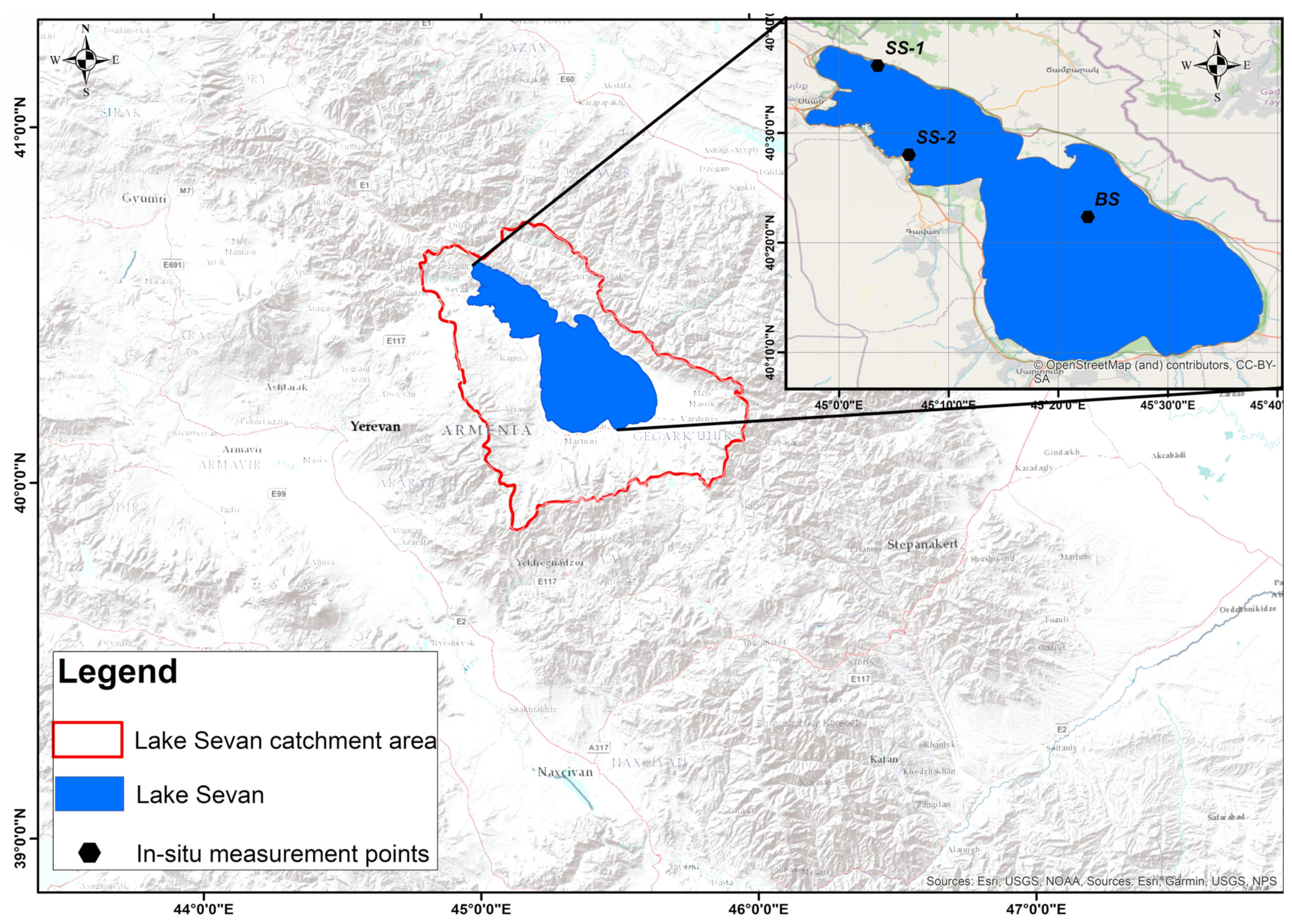
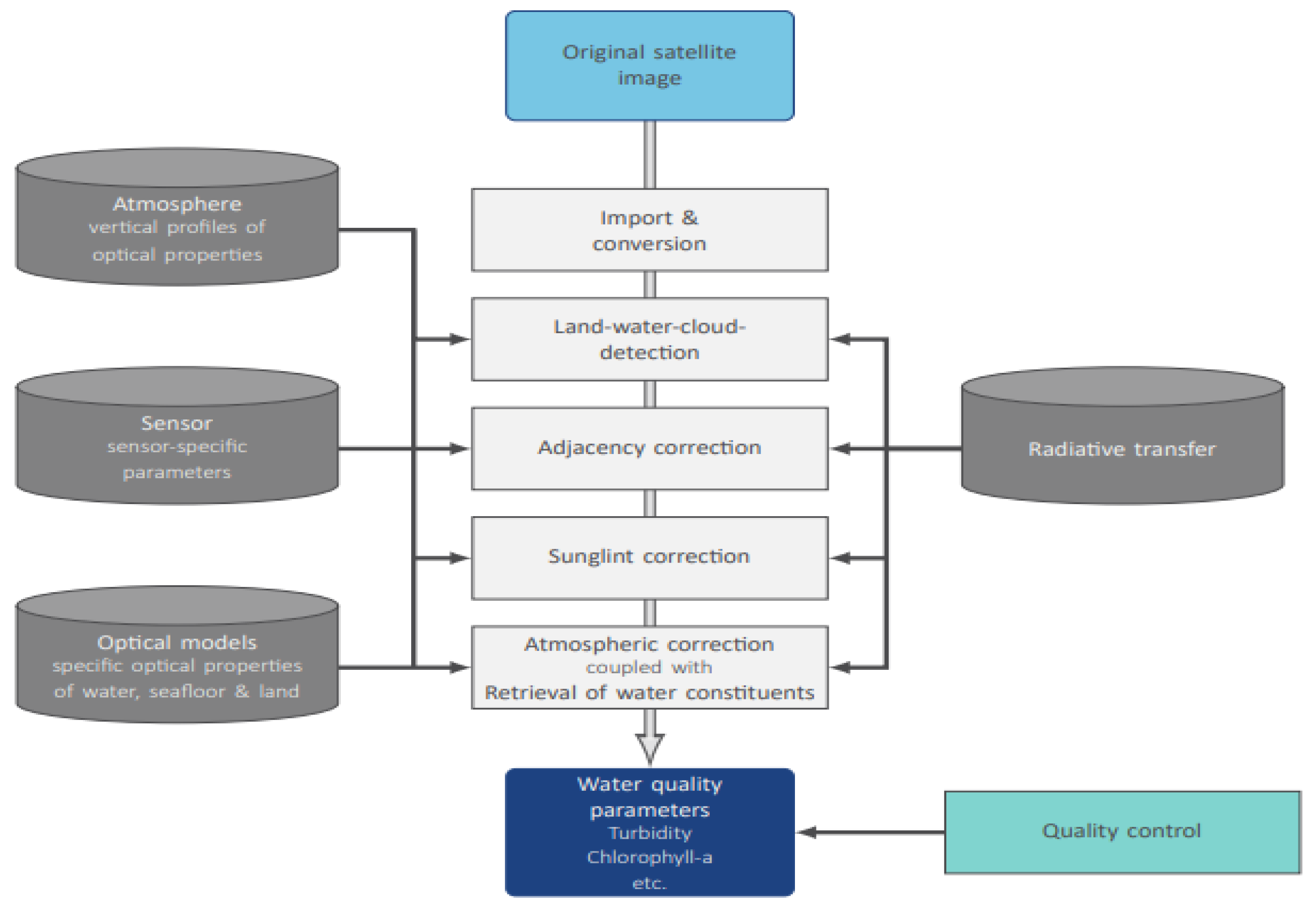

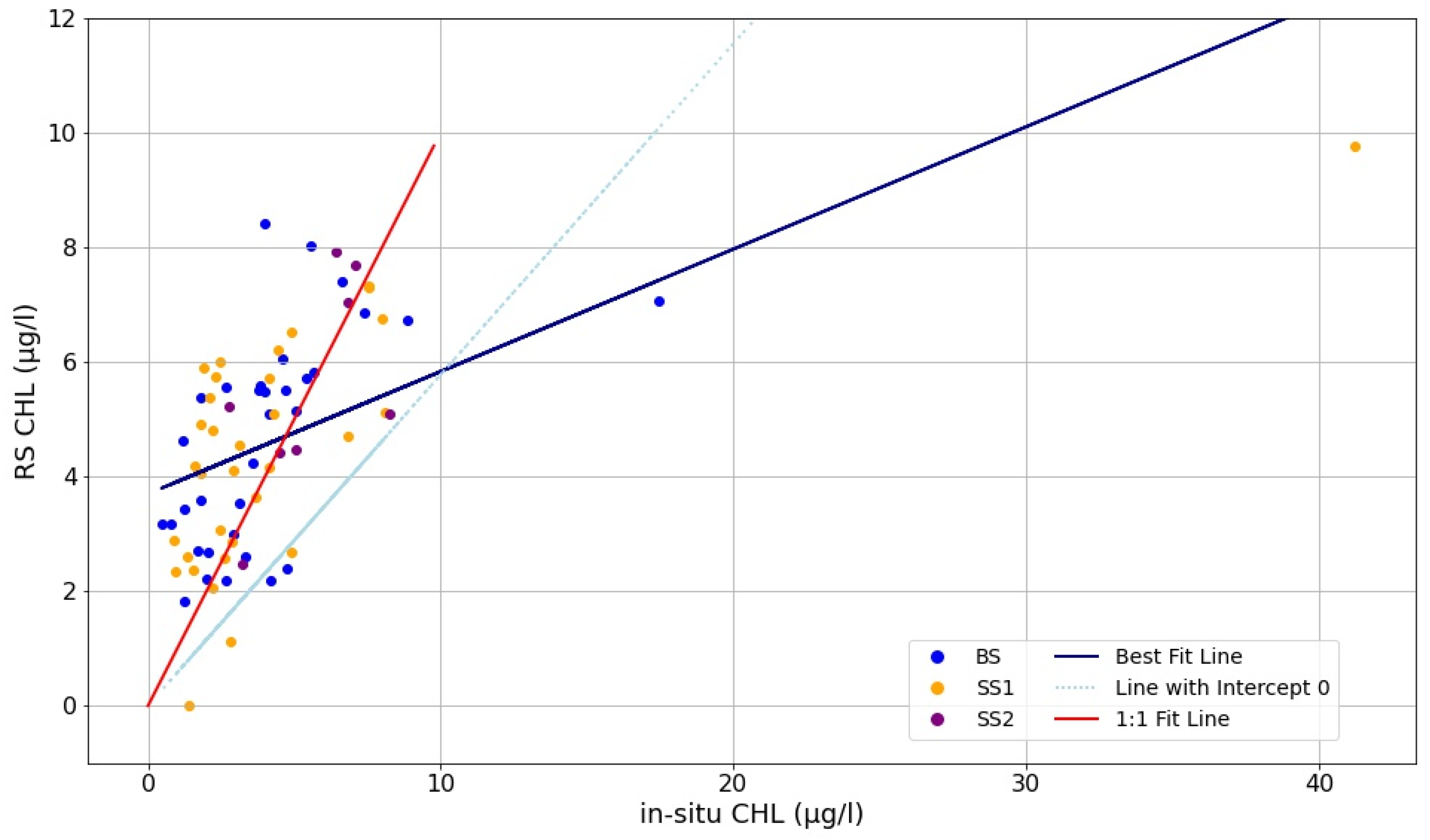

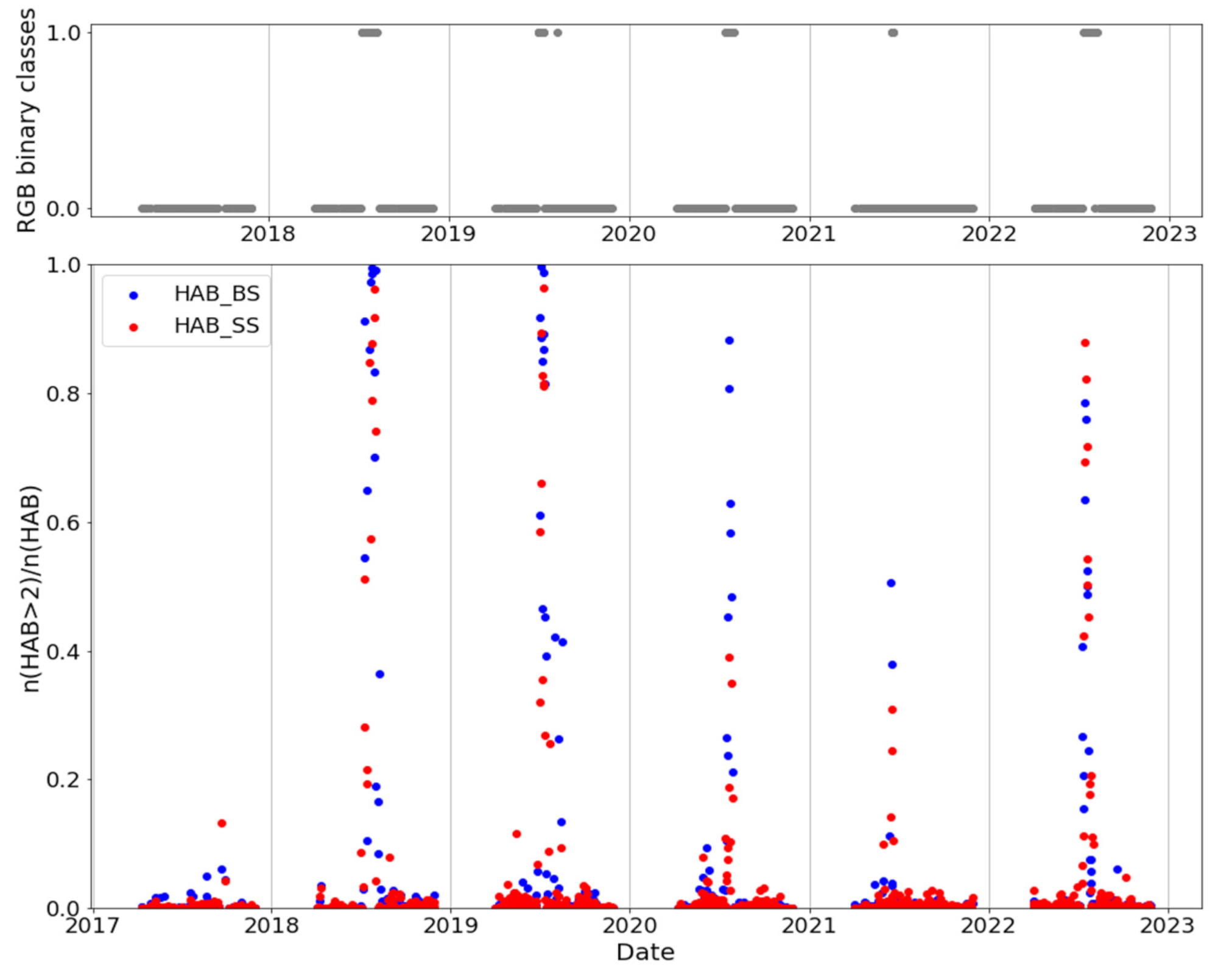
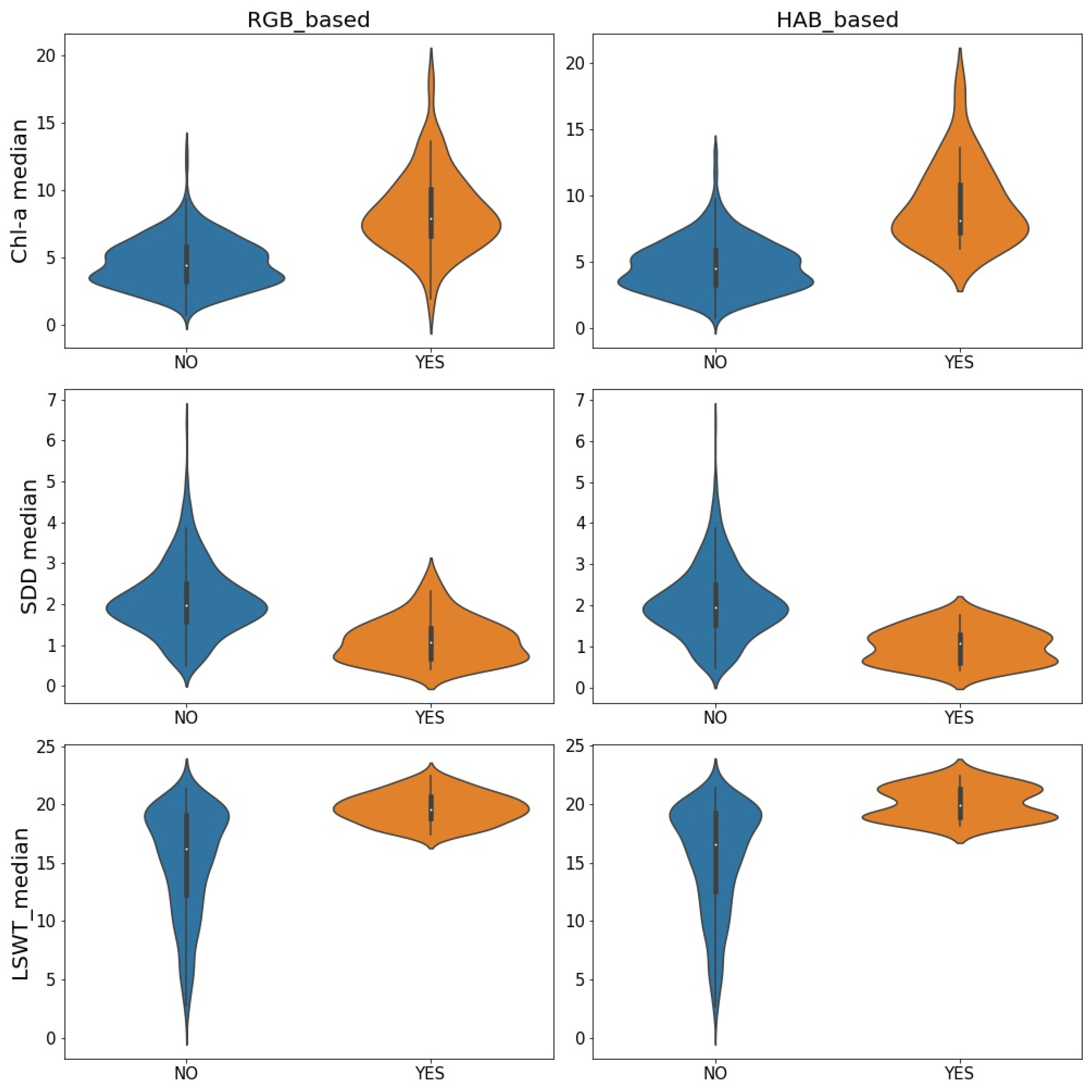
| Small Sevan | Big Sevan | Entire Lake Sevan | |
|---|---|---|---|
| Water level [m.a.s.l.] | 1900.43 | 1900.43 | 1900.43 |
| Surface area [km2] | 338.314 | 939.53 | 1277.844 |
| Volume [km3] | 14.0647 | 24.0228 | 38.0875 |
| Maximum depth [m] | 80.5 | 30.5 | 80.5 |
| Inflows | 4 rivers | 24 rivers + Arpa − Sevan tunnel | 28 rivers + Arpa − Sevan tunnel |
| Outflows | 1 (Hrazdan River) | - | 1 (Hrazdan River) |
| N | Sampling Period | Sampling Site | Latitude | Longitude |
|---|---|---|---|---|
| 1 | April–November 2018–2021 | Big Sevan (BS) | 40°22′21″N | 45°22′42.30″E |
| 2 | April–November 2018–2021 | Small Sevan (SS_1) | 40°36′8.16″N | 45°3′32.64″E 45.059067E |
| 3 | April–November 2021 | Fish Farm (SS_2) | 40°28′0.40″N | 45°6′23.10″E |
| RGB_Binary | ||||
|---|---|---|---|---|
| NO | YES | |||
| HAB | NO (HAB ≤ 2) | 643 | 29 | 672 |
| YES (HAB > 2) | 0 | 28 | 28 | |
| 643 | 57 | 700 | ||
| Single-Factor Models’ | |||
|---|---|---|---|
| Response Variable | Explanatory Variable | p | Pseudo-R2 |
| HAB-based bloom | Chlorophyll | <0.001 | 0.36 |
| detection | Secchi Depth | <0.001 | 0.23 |
| LSWT | <0.001 | 0.26 | |
| RGB-based bloom | Chlorophyll | <0.001 | 0.33 |
| detection | Secchi Depth | <0.001 | 0.22 |
| LSWT | <0.001 | 0.24 | |
| Best Multiple Models | |||
| HAB-based bloom | Chlorophyll | <0.001 | 0.59 |
| detection | LSWT | <0.001 | |
| RGB-based bloom | Chlorophyll | 0.005 | 0.58 |
| detection | LSWT | <0.001 | |
| Chlorophyll/LSWT | 0.048 | ||
| (A) Chlorophyll(CHL)Concentrations | ||||
| Variable | Estimate | Std. Error | t value | p |
| Intercept | 4.767 | 0.082 | 57.9 | <0.001 |
| Bloom = TRUE | 4.061 | 0.236 | 17.2 | <0.001 |
| Method = RGB | −0.19 | 0.116 | −1.63 | 0.103 |
| (B) Secchi Disc Depth (SDD) | ||||
| Variable | Estimate | Std. Error | t value | p |
| Intercept | 2.05 | 0.035 | 58.21 | <0.001 |
| Bloom = TRUE | −0.98 | 0.101 | −9.77 | <0.001 |
| Method = RGB | 0.05 | 0.046 | 0.93 | 0.354 |
| (C) LakeWater Surface Temperature (LWST) | ||||
| Variable | Estimate | Std. Error | t value | p |
| Intercept | 15.4314 | 0.1837 | 83.99 | <0.001 |
| Bloom = TRUE | 4.5354 | 0.5261 | 8.621 | <0.001 |
| Method = RGB | −0.2119 | 0.2592 | −0.817 | 0.414 |
Disclaimer/Publisher’s Note: The statements, opinions and data contained in all publications are solely those of the individual author(s) and contributor(s) and not of MDPI and/or the editor(s). MDPI and/or the editor(s) disclaim responsibility for any injury to people or property resulting from any ideas, methods, instructions or products referred to in the content. |
© 2024 by the authors. Licensee MDPI, Basel, Switzerland. This article is an open access article distributed under the terms and conditions of the Creative Commons Attribution (CC BY) license (https://creativecommons.org/licenses/by/4.0/).
Share and Cite
Asmaryan, S.; Khlghatyan, A.; Hovsepyan, A.; Muradyan, V.; Avetisyan, R.; Gevorgyan, G.; Hayrapetyan, A.; Eissa, M.M.A.A.; Bernert, H.; Schultze, M.; et al. Satellite-Based Detection of Algal Blooms in Large Alpine Lake Sevan: Can Satellite Data Overcome the Unavoidable Limitations in Field Observations? Remote Sens. 2024, 16, 3734. https://doi.org/10.3390/rs16193734
Asmaryan S, Khlghatyan A, Hovsepyan A, Muradyan V, Avetisyan R, Gevorgyan G, Hayrapetyan A, Eissa MMAA, Bernert H, Schultze M, et al. Satellite-Based Detection of Algal Blooms in Large Alpine Lake Sevan: Can Satellite Data Overcome the Unavoidable Limitations in Field Observations? Remote Sensing. 2024; 16(19):3734. https://doi.org/10.3390/rs16193734
Chicago/Turabian StyleAsmaryan, Shushanik, Anahit Khlghatyan, Azatuhi Hovsepyan, Vahagn Muradyan, Rima Avetisyan, Gor Gevorgyan, Armine Hayrapetyan, Mayada Mohamed Alshahat Arafat Eissa, Hendrik Bernert, Martin Schultze, and et al. 2024. "Satellite-Based Detection of Algal Blooms in Large Alpine Lake Sevan: Can Satellite Data Overcome the Unavoidable Limitations in Field Observations?" Remote Sensing 16, no. 19: 3734. https://doi.org/10.3390/rs16193734
APA StyleAsmaryan, S., Khlghatyan, A., Hovsepyan, A., Muradyan, V., Avetisyan, R., Gevorgyan, G., Hayrapetyan, A., Eissa, M. M. A. A., Bernert, H., Schultze, M., & Rinke, K. (2024). Satellite-Based Detection of Algal Blooms in Large Alpine Lake Sevan: Can Satellite Data Overcome the Unavoidable Limitations in Field Observations? Remote Sensing, 16(19), 3734. https://doi.org/10.3390/rs16193734






